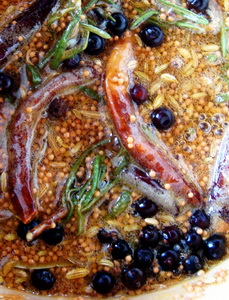Caramelised Onion Jam
A fantastic jam that goes with so many things - wonderful in a steak sandwich, with sausages, or cheese, great with pâté, is a must at Christmas time in the Davies family to have with leftover sandwiches for the ham and turkey. Kyla, my sister, makes a batch every year giving us a jar each as one of our pressies. It is difficult to find an onion jam that caramelises the onions to this extent, and this amount of caramelisation is exactly what you want in an onion jam. So good it should be sold in stores - a treat to have this one, but it is an effort to make.
"I do this one by feel; it works well when you do a much smaller amount too..."- Kyla Davies.
Pictured: Caramelised Onion Jam
1 bag onions, i.e. 15-20, sliced 5mm thick
1 kg sugar
10 whole dried chillies
Small handful juniper berries
Small bag yellow mustard seeds
Handful bay leaves
Few sprigs thyme and/or rosemary
Small handful fennel seeds
1 – 2 cups malt vinegar
1 cup brown sugar
Salt
Make a caramel with the sugar and a little water – see Caramel Cooking Tips below.
Add - dried chillies, juniper berries, yellow mustard seeds, bay leaves, thyme/rosemary, and fennel seeds.
When caramel is starting to go brown and bubbly, throw in the sliced onions and give it a light stir to coat.
Let it bubble away until the onion goes transparent and the juice of the onion that has come out is cooked down so it's caramelly again – this can take a while if doing a large batch as per recipe quoted.
Add brown sugar and malt vinegar to taste while jam is still warm to dissolve the sugar.
Add salt at end if desired.
Place into sterilised jars.
Makes 4 - 6 jars
 Pictured: Onion Jam- Adding the herbs and spices after the caramel has been made
Pictured: Onion Jam- Adding the herbs and spices after the caramel has been made
TasteTip – Bay leaves are one of the few herbs that don’t lose its flavour when dried and in fact are even more strongly flavoured than fresh. Fresh leaves are becoming more widely available. Bay leaves are a versatile store-cupboard ingredient and anyone who loves slow cooking will have them in their spice rack, which brings out the flavour more and more over the slow cooking time.
Caramel Cooking Tips
DRY METHOD - In this method, sugar is simply melted in a pan without any additional ingredients. I recommend a medium to medium-high heat. As sugar cooks, it melts and creates a thick syrup that, when boiled, reaches the caramel stage. Wait for sugar to melt before stirring and make sure that sugar is completely dissolved before it starts boiling. Once boiling, swirl the pan occasionally, but do not stir.
This method involves very close attention. The sugar can clump and melt unevenly. What’s more, if even a little bit of it begins to burn, your batch is ruined. If your caramel turns out bitter, you know you over cooked it.
WET METHOD - Sugar is combined with water or another liquid, creating a thin sugar syrup. (Use milk for a very light coloured caramel) During the boiling process, excess liquids evaporate, causing the syrup to thicken, the sugar concentration to increase, and the colour to change from opaque to a rich, golden brown. DO NOT stir after concoction is boiled. (Explanation to come) This method takes longer, but is easier to control and doesn’t burn as easily. This method is recommended for beginners.
Combine sugar and other ingredients in a heavy pan over medium heat. Stir only until sugar is dissolved. Again, once boiling, swirl the pan occasionally, but do not stir.
AVOIDING PROBLEMS - When making caramel, there is a danger of crystallization - the formation of sugar crystals that can interfere with the syrup's texture. If the pan or spoon is not completely clean, if the syrup is stirred once it boils, or if the sugar is not properly dissolved, you’ll get lumps of sugar in the caramel.
This however is easy to avoid. First, make sure you have a perfectly smooth, clean pan. Do not forget to avoid stirring. To test the consistency, simply swirl it around in your pan.
Once the syrup begins to turn a light gold colour, watch it very carefully. You may want to take the pan off the heat for a minute to slow down the cooking. The heat of the pan will continue to cook the caramel and you will be able to control the heat. To test for proper colour, take a spoonful from the pan and drip it on a paper plate or white napkin. The colour should be rich golden brown.
If you want to use a candy thermometer, cook to about 340°F - 350°F. However, I find it easier to watch for the desired colour.
To stop the cooking, place the pan in a bowl of cold water. This assures that the consistency stays like you want it. When you do this, be very careful not to splash any water into you caramel.

 Tastebuddy
Tastebuddy